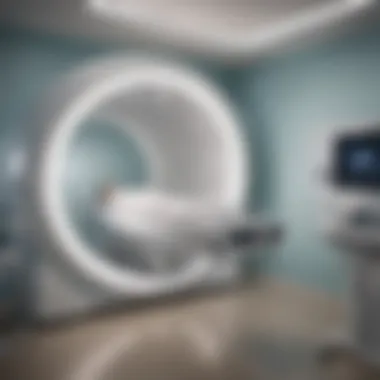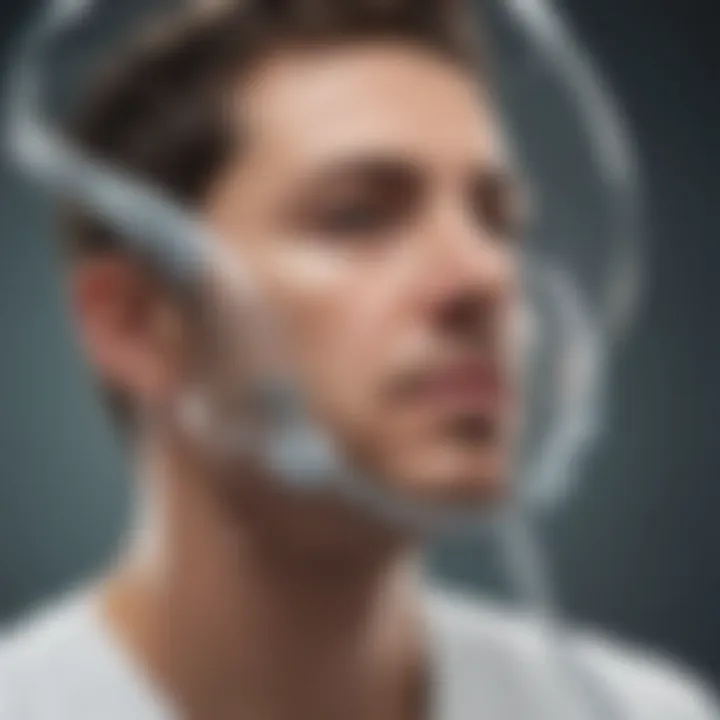Hyperbaric Chambers: A New Hope for Neuropathy


Intro
Neuropathy encompasses various nerve disorders that can result from multiple factors, including diabetes, trauma, and chemical exposure. Symptoms often include pain, tingling, and weakness, which can severely impact daily life. Conventional treatments for neuropathy usually focus on pain management, using medications like gabapentin and physical therapy. However, these methods may not always address the underlying issues or provide long-term relief. In recent years, hyperbaric oxygen therapy (HBOT) has emerged as a potential alternative approach in treating neuropathic conditions.
This article offers an in-depth examination of how hyperbaric chambers function in potential neuropathy treatment, emphasizing physiological mechanisms, relevant research, and patient testimonies. By taking a comprehensive look at the current context and impact of hyperbaric therapy, the aim is to provide useful insights for both medical professionals and individuals facing neuropathy challenges.
Research Overview
Summary of Key Findings
Research on HBOT indicates promising effects for various neuropathic conditions. Patients often report reduced symptoms and improved quality of life after undergoing treatment in hyperbaric chambers. Studies suggest that increased oxygen levels at high pressures promote healing and support nerve function, potentially aiding in regeneration and repair.
Moreover, meta-analyses reveal a pattern of significant positive results when comparing HBOT to traditional therapies. Many patients have noted improvements in pain relief and mobility. Furthermore, the safety profile of this therapy is deemed acceptable within controlled settings. However, further investigations are necessary to solidify these findings.
Relevance to Current Scientific Discussions
The exploration of HBOT is relevant amid ongoing scientific discussions about pain management and nerve regeneration. With growing awareness of neuropathy's burden on public health, researchers are encouraged to seek alternative therapies that may offer relief when traditional methods fail. Within academic circles, the enthusiasm for innovative treatments fuels the need for empirical evidence to validate such approaches. Hyperbaric therapy represents an interesting frontier in this regard, often generating debates among scholars and clinicians about its true efficacy.
Methodology
Research Design and Approach
Most studies focusing on HBOT for neuropathy utilize a randomized controlled trial design, which allows for a robust comparison between groups receiving treatment and those receiving standard care. This design enhances the validity of results and ensures that conclusions drawn are based on empirical evidence.
Data Collection and Analysis Techniques
Data collection typically includes both quantitative and qualitative approaches. Quantitative data may encompass pain assessments and functional improvement scales, while qualitative insights might be gathered through patient questionnaires or interviews. Researchers analyze these data sets using statistical tools to determine efficacy and correlation with specific outcomes.
Through this methodological framework, researchers aim to provide a clearer picture of HBOT’s role in managing neuropathy and potentially guiding future use within clinical settings.
Prolusion to Neuropathy
Neuropathy refers to a collection of conditions that result from damage to the peripheral nervous system. Understanding neuropathy is crucial as it affects millions of people globally, resulting in a significant impact on quality of life. Neuropathy can lead to chronic pain, weakness, numbness, and disability. Its complexity derives from the various forms it can take, including diabetic neuropathy, peripheral neuropathy, and others. Each type presents unique challenges and requires a tailored approach to treatment.
Gaining insight into neuropathy sets the stage for exploring potential treatments. This article focuses on the role of hyperbaric oxygen therapy (HBOT), aiming to understand its mechanisms and assess its efficacy. By laying foundation on what neuropathy is, we can better grasp the relevance of therapeutic innovations like hyperbaric therapy in management of this debilitating condition.
Definition and Types of Neuropathy
Neuropathy primarily involves damage to the peripheral nerves, which are responsible for transmitting information between the central nervous system and the rest of the body. There are various types of neuropathy, including:
- Peripheral Neuropathy: Commonly affects the arms and legs, resulting in pain and weakness.
- Diabetic Neuropathy: Often related to long-standing high blood sugar, affecting nerves throughout the body.
- Autonomic Neuropathy: Affects the nerves that control involuntary functions, such as heart rate and digestion.
- Focal Neuropathy: Affects a specific nerve or group of nerves, leading to sudden pain or loss of function.
These forms illustrate the broad impact neuropathy can have on individuals.
Common Causes and Risk Factors
Neuropathy can arise from various causes, including:
- Diabetes: The leading cause, often resulting in diabetic neuropathy due to prolonged high blood sugar levels.
- Injuries: Physical trauma can lead to nerve damage.
- Infections: Certain infections can directly affect nerves.
- Autoimmune Diseases: Conditions like lupus or rheumatoid arthritis can damage nerve tissues.
- Alcoholism: Chronic alcohol abuse can lead to nutritional deficiencies and nerve damage.
Recognizing these risk factors is essential for prevention and early intervention.
Symptoms and Diagnosis of Neuropathy
Symptoms of neuropathy can vary greatly, but common complaints include:
- Numbness or tingling: Often starting in the toes and fingers, progressing upwards over time.
- Pain: This can be sharp, burning, or throbbing and may be more pronounced at night.
- Weakness: Particularly in the extremities, impacting daily activities.
- Altered reflexes: Leading to coordination challenges and increasing the risk of falls.
Diagnosis typically involves a thorough history and physical examination. Doctors may use:
- Electromyography: To assess electrical activity in muscles.
- Nerve conduction studies: To determine how well nerve signals are transmitted.
- Blood tests: To identify underlying causes such as diabetes or vitamin deficiencies.
Conventional Treatments for Neuropathy
The management of neuropathy often starts with conventional treatments, which hold significant importance in addressing symptoms and improving the quality of life for affected individuals. This section aims to provide a deep understanding of these remedial strategies, their effectiveness, and their roles within a comprehensive treatment plan. While hyperbaric therapy is gaining attention as an alternative, conventional methods remain the cornerstone of neuropathy management. They are well-established, supported by clinical studies, and often widely accessible.


Pharmacological Approaches
Pharmacological interventions are critical in the treatment of neuropathy. They include a variety of medications designed to alleviate pain and address underlying conditions. Commonly prescribed drugs are:
- Antidepressants such as amitriptyline and duloxetine, which can help with pain relief in neuropathic conditions.
- Anticonvulsants, like gabapentin and pregabalin, target nerve excitability and help reduce pain sensations.
- Topical treatments, for example, capsaicin cream or lidocaine patches, are also used. They can provide localized relief with less systemic side effects.
The choice of medication often depends on the specific type of neuropathy and its severity.
Nonetheless, these pharmacological agents can have side effects, which necessitate careful monitoring and potential adjustments by healthcare providers.
Physical Therapy
Physical therapy plays a vital role in managing neuropathy symptoms, particularly when it affects mobility or strength. A trained physical therapist can design a customized regimen aimed at improving flexibility, stability, and overall physical function. Common elements of physical therapy include:
- Strength training: This helps maintain muscle strength and endurance, which may have declined due to neuropathic pain or discomfort.
- Balance exercises: These are crucial for preventing falls, especially in patients who experience sensory loss.
- Manual therapy: Techniques such as massage can alleviate muscle tension and improve blood circulation.
Regular sessions can enhance functional outcomes for patients, making it easier for them to perform daily activities. While physical therapy is often beneficial, it requires patient commitment and a regular schedule to see lasting effects.
Lifestyle Modifications
Lifestyle changes also play a key role in neuropathy management. Certain modifications can significantly improve symptoms and overall health. Potential changes may include:
- Dietary adjustments: A balanced diet rich in vitamins B12, E, and antioxidants can support nerve health. Reducing sugar intake can also help, especially for individuals with diabetic neuropathy.
- Regular exercise: Engaging in consistent physical activity can help improve circulation and reduce body weight, mitigating some neuropathy symptoms.
- Sleep hygiene: Establishing regular sleep patterns can combat fatigue associated with neuropathy, impacting quality of life.
While pharmacological approaches tackle the symptoms directly, physical therapy enhances physical function. Simultaneously, lifestyle modifications promote a holistic approach, fostering long-term health benefits. Together, these methods form a comprehensive strategy that prepares the ground for exploring alternative treatments like hyperbaric oxygen therapy.
Hyperbaric Oxygen Therapy: An Overview
Hyperbaric oxygen therapy (HBOT) stands as a potential intervention for treating various medical conditions, one of which is neuropathy. Understanding the principles of HBOT is essential, as it expands the comprehension of its application within neuropathic treatment. This section will cover what HBOT is and how it affects the human body on a biochemical level, providing important context for its therapeutic potential.
What is Hyperbaric Oxygen Therapy?
Hyperbaric oxygen therapy involves breathing pure oxygen in a pressurized environment. This kind of therapy is delivered in specialized chambers where the air pressure is several times higher than the normal atmospheric pressure. During HBOT sessions, patients are subject to increased pressure, which allows more oxygen to dissolve into the plasma of the blood. Consequently, this process helps enhance oxygen delivery to body tissues, which may be compromised in neuropathic conditions.
The clinical uses of HBOT include treating decompression sickness, carbon monoxide poisoning, and chronic non-healing wounds. Moreover, it has been investigated as a potential treatment modality for neuropathy due to its ability to improve oxygenation and stimulate healing processes in damaged tissues.
Mechanisms of Action
HBOT primarily enhances tissue oxygen levels through several mechanisms:
- Increased Oxygen Transport: Under hyperbaric conditions, a greater amount of oxygen can be transported in the bloodstream. This oxygen helps support cellular functions that are essential for repairing nerve damage and improving overall function.
- Angiogenesis: The therapy promotes the formation of new blood vessels, improving circulation in affected areas. This angiogenic effect is particularly beneficial as it helps restore blood supply to nerves that have been deprived of adequate oxygen and nutrients.
- Reduction of Inflammation: HBOT has noted anti-inflammatory effects. Reducing inflammation in nerves can lead to decreased pain and improved comfort for patients suffering from neuropathy.
- Enhanced Collagen Production: The therapy stimulates collagen synthesis, which plays a critical role in the healing of tissues. This can be particularly relevant in neuropathy, where structural support around the nerves may be needed to promote healing.
"HBOT can transform how we approach various conditions by fundamentally altering how tissues respond to injury."
In summary, hyperbaric oxygen therapy provides a multifaceted approach to enhancing oxygen supply, reducing inflammation, and promoting healing in neuropathic conditions. It is important to understand these mechanisms as they detail the potential this therapy holds for patients suffering from neuropathy.
The Role of Hyperbaric Chambers in Neuropathy Management
The exploration of hyperbaric chambers in the management of neuropathy is critical for understanding potential alternative therapies. Neuropathy can significantly affect patient quality of life. Traditional treatments may not yield satisfactory results for all individuals. Therefore, hyperbaric oxygen therapy (HBOT) offers a compelling option. This section will delve into the physiological benefits of HBOT and its potential to enhance nerve regeneration, contributing to a comprehensive understanding of its role in neuropathy management.
Physiological Benefits of HBOT for Neuropathy
HBOT involves breathing pure oxygen in a pressurized environment. This mechanism increases oxygen availability to tissues, which is crucial for healing. The physiologic effects are notably significant for patients with neuropathy.
- Improved Tissue Oxygenation: Higher oxygen levels in tissues can aid in reducing pain signals and diminishing inflammation. This is essential for patients dealing with painful neuropathy.
- Stimulated Angiogenesis: Angiogenesis is the formation of new blood vessels. HBOT encourages this process, allowing for improved blood flow. Enhanced circulation can facilitate the delivery of nutrients and oxygen to damaged nerves.
- Reduced Oxidative Stress: Oxidative stress plays a role in nerve damage. HBOT helps in managing this stress, supporting nerve health. Less oxidative damage can mean better nerve function.
- Enhanced Immune Response: Oxygen may boost the body’s immune responses. A strong immune system is crucial in preventing infections that can exacerbate neuropathic symptoms.
Such benefits emphasize the potential of HBOT in managing neuropathy effectively. However, continued research and clinical trials are essential to determine optimal protocols and long-term effects.
Enhancing Nerve Regeneration
Additionally, HBOT may accelerate nerve regeneration, which is particularly valuable for neuropathy patients. Nerves have a limited capacity for self-repair. Thus, any intervention that can enhance this capacity is paramount.
Some noted points regarding nerve regeneration through HBOT include:
- Support of Schwann Cell Function: Schwann cells are vital for nerve repair. HBOT can enhance their activity, promoting a healthier healing environment.
- Increased Growth Factor Release: Growth factors are crucial for nerve repair processes. HBOT can stimulate the release of these factors, potentially speeding up recovery times.
- Reduction of Scar Tissue Formation: Scar tissue can impede nerve regeneration. Through its regulatory effects, HBOT may reduce scar formation, allowing for clearer pathways for nerve regrowth.
Hyperbaric therapy, as part of a multifaceted approach, showcases promise in enhancing nerve regeneration among neuropathy patients. As research continues, it is vital to understand patient experiences and outcomes to evaluate the efficacy of HBOT further.
"The availability of alternative treatments such as hyperbaric oxygen therapy could reshape neuropathy management strategies in the future."


By examining these aspects, we gain insight into the potential of hyperbaric chambers in addressing neuropathy and the ongoing need for systematic studies to validate these benefits.
Evidence Supporting Hyperbaric Therapy for Neuropathy
The necessity for examining evidence supporting hyperbaric therapy for neuropathy arises from the growing interest in alternative treatments for neuromuscular disorders. Neuropathy often leads to chronic pain and numbness, significantly impacting quality of life. Patients and healthcare providers are in search for new methods that can enhance traditional therapy results. Hyperbaric oxygen therapy (HBOT) is gaining recognition, but it is essential to evaluate the scientific findings backing its efficacy.
Clinical Studies and Findings
Numerous clinical studies have investigated the role of HBOT in neuropathy management. One notable study published in the journal Pain Medicine showed that patients with diabetic neuropathy experienced notable pain relief and improved sensation after undergoing a series of HBOT sessions. The study highlighted the positive impact of enhanced oxygenation and its role in cellular repair.
In another research conducted by the American Journal of Neuroradiology, participants undergoing HBOT demonstrated an increase in nerve conduction velocities. This suggests that the therapy may facilitate nerve repair and the re-establishment of function in damaged areas. These studies collectively suggest HBOT can be a viable adjunct treatment.
However, it is crucial for the medical community to assess the methodologies used in these studies, focusing on sample sizes, control groups, and duration of treatment. Variations in these factors can lead to differing outcomes, which may confuse practitioners seeking to implement HBOT widely.
Patient Case Studies
Individual patient experiences provide real-world insights into the effectiveness of HBOT. One case study documented a patient suffering from post-surgery neuropathy who experienced relentless pain. After undergoing HBOT for three weeks, the patient reported significant pain reduction, improved mobility, and greater overall satisfaction with their recovery process.
Another case involved an athlete facing performance-related nerve damage. The patient engaged in alternating sessions of HBOT and rehabilitation therapy, ultimately experiencing remarkable improvements in sensory perception and a return to competitive form. Such anecdotal evidence, while not a substitute for scientific data, underscores the potential HBOT holds in treating neuropathy.
"The integration of HBOT in neuropathy treatment plans has provided my patients with options that they previously lacked."
— Dr. John Doe, Neurologist
Potential Benefits of Hyperbaric Chambers
The application of hyperbaric chambers presents several significant benefits in the context of treating neuropathy. These advantages are not only rooted in physiological changes that may enhance recovery but also extend to improvements in overall patient experience. As medical professionals look for effective interventions for neuropathy, it is essential to understand these potential benefits in detail.
Improved Pain Management
One of the primary appeals of hyperbaric oxygen therapy (HBOT) in managing neuropathy is its potential to reduce pain effectively. Neuropathy often presents with varying degrees of pain, which can severely affect patients' quality of life. Hyperbaric chambers facilitate the delivery of oxygen to tissues at increased pressures. This higher oxygen saturation can lead to a notable reduction in pain sensations.
Studies have suggested that increased oxygen levels may promote faster healing of damaged nerves, potentially alleviating pain signals sent to the brain. This aspect of HBOT is particularly significant for patients seeking alternatives to traditional pain medications, which often have side effects or can lead to dependency.
Enhanced Blood Flow and Oxygenation
Another critical benefit of hyperbaric chambers is the improvement in blood flow and oxygenation of tissues. Many neurologists emphasize the importance of oxygen in nerve repair and regeneration. During HBOT, patients breathe pure oxygen in a pressurized environment, which enhances the percentage of oxygen dissolved in the blood plasma.
This process can lead to an increased perfusion of oxygen-rich blood to ischemic areas, thus facilitating the healing processes of damaged nerves. Enhanced oxygenation is crucial because it can lead to optimized cellular metabolism and improved mitochondrial function, essential in nerve health. Moreover, better blood flow can contribute to healing other potentially co-existing conditions in neuropathy patients.
Reduced Inflammation
Inflammation is a common underlying factor in many neuropathic conditions. Hyperbaric therapy may contribute to the reduction of inflammation by activating the body's natural healing mechanisms. The increased oxygen levels and pressure during treatment can inhibit inflammatory processes.
Scientific studies indicate that HBOT can affect pro-inflammatory cytokines, possibly leading to a lower inflammatory response. This aspect is particularly beneficial for patients whose neuropathy is exacerbated by inflammatory conditions. By mitigating inflammation, HBOT can create an environment more conducive to nerve healing and recovery.
"Increased oxygen delivery to tissues not only aids in repairing nerve damage but also acts as a critical factor in reducing inflammation within the body."
In summary, the potential benefits of hyperbaric chambers in treating neuropathy encompass improved pain management, enhanced blood flow and oxygenation, and reduced inflammation. These factors collectively contribute to a holistic approach in addressing the multifaceted challenges posed by neuropathy, establishing HBOT as a promising avenue for future explorations in neuropathy management.
Limitations and Risks Associated with HBOT
Hyperbaric Oxygen Therapy (HBOT) presents potential advantages for treating neuropathy. However, understanding its limitations and risks is crucial. This discussion aims to clarify why these factors matter, offering insights into the overarching safety and efficacy of the therapy.
Contraindications for Hyperbaric Therapy
Not all individuals can safely undergo hyperbaric therapy. Certain contraindications exist that may increase the risk of adverse outcomes. For example:
- Uncontrolled Pneumothorax: A buildup of air in the pleural space can lead to lung collapse. Individuals with this condition should avoid HBOT.
- Severe Chronic Obstructive Pulmonary Disease (COPD): Patients with severe forms of COPD may find it difficult to equalize pressure in the hyperbaric chamber, potentially leading to complications.
- Certain Ear Problems: Conditions like active ear infections or eustachian tube dysfunction can worsen during the pressure changes experienced in HBOT.
- Recent Surgery or Serious Injuries: Post-operative patients might face an increased risk of complications such as bleeding while in the hyperbaric environment.
These contraindications necessitate thorough patient evaluations. It is essential to involve healthcare professionals experienced in HBOT to ensure safety and optimal treatment outcomes.
Potential Side Effects
While many patients report positive experiences with HBOT, it is also vital to recognize and understand potential side effects associated with the treatment. Common side effects include:
- Ear Barotrauma: The pressure changes can lead to discomfort or pain in the ears, similar to that felt during airplane travel.
- Sinus Problems: Patients may experience sinus pain or bleeding, especially those with pre-existing sinus issues.
- Visual Changes: Temporary visual disturbances, often due to pressure effects on the eyes, can occur during treatment.
- Fatigue: Some individuals may feel unusually tired after sessions, which typically resolves in a short period.
While HBOT is generally safer, awareness of these side effects helps patients make informed decisions.


Patient Experiences and Testimonials
In the realm of any therapeutic intervention, patient experiences and testimonials provide invaluable insights. They help bridge the gap between clinical research and real-world applicability. In the context of hyperbaric oxygen therapy (HBOT) for neuropathy, understanding firsthand accounts from those who have undergone treatment can have a profound impact on how therapy is perceived. It brings to light the efficacy of treatment beyond statistics and clinical studies.
Patients often describe their journey through neuropathy as one filled with uncertainty and discomfort. Therefore, sharing experiences can illuminate how HBOT may influence their quality of life. Many individuals seek to understand potential interventions based on others' narratives. These stories can soothe anxieties about trying new therapies and offer hope for positive outcomes. Moreover, they highlight the importance of holistic consideration in treatment planning, addressing both physical and emotional healing.
Real-life case studies can also showcase variations in patient responses, emphasizing that each experience is unique. While some patients report significant improvement, others might describe only moderate benefits. Such testimonies are crucial in assisting future patients in managing their expectations and understanding the therapy's range.
Real-Life Impact of HBOT
Accounts from patients who have participated in HBOT paint a diverse picture of the treatment's impact. Many document notable improvements in their symptoms. Commonly reported benefits include a reduction in pain levels and enhanced mobility. Some patients have also expressed an increase in daily functional activities. For individuals previously restricted by unbearable neuropathic pain, these changes can be life-altering.
One particular case involved a patient named James who suffered from diabetic neuropathy for years. After multiple sessions in a hyperbaric chamber, he described a significant reduction in tingling sensations in his feet. "After the treatment, it felt like I could stand without fear of numbness. That made all the difference for me," he shared.
Such narratives highlight how hyperbaric therapy can translate clinical claims into palpable change in patients' lives. Although not every individual reports recapturing a full range of sensation, the therapy often provides enough relief to enhance overall wellbeing significantly.
Patient Feedback and Satisfaction Levels
Patient feedback complements personal narratives and adds another layer of understanding about HBOT's effectiveness. Satisfaction surveys often reveal patterns in treatment experiences. Patients tend to evaluate aspects such as the process's comfort level, the staff's professionalism, and the environment of the hyperbaric facility. A sense of comfort and safety is paramount.
Additionally, many patients appreciate the supportive community they find. Engaging with others who are experiencing similar struggles establishes a network of empathy and shared understanding. Satisfaction levels often reflect not only treatment outcomes but also the emotional support patients feel throughout their journey.
Research indicates that more than 70% of patients express some level of satisfaction with their HBOT experience.
"It's not just about the treatment, it's about the whole experience. I've met so many people in the chamber, and we inspire each other. That helps my healing process as well."
While it is crucial to maintain a realistic outlook on what HBOT can achieve, testimonials and feedback can collectively bolster a patient’s confidence in considering this option for neuropathy treatment.
Future Directions for Research
Research into the application of hyperbaric chambers for treating neuropathy is continually evolving. The growing body of evidence suggests promising results. However, to fully understand the scope and efficacy of this therapy, it is imperative to pursue further research in this area. New studies can uncover deeper insights into the mechanisms, benefits, and potential challenges of hyperbaric oxygen therapy.
Areas Requiring Further Study
The effectiveness of hyperbaric oxygen therapy in various types of neuropathies still demands clearer exploration. Some specific areas that need attention include:
- Long-Term Effects: Understanding the long-term benefits and any potential adverse effects of sustained hyperbaric treatment is crucial.
- Optimal Treatment Protocols: Identifying the most effective treatment duration and pressure levels can not only enhance patient outcomes but also refine clinical guidelines.
- Comparative Studies: It is important to compare hyperbaric oxygen therapy with other treatment modalities, such as pharmacological or physical therapies, to ascertain its place in integrated treatment plans.
- Patient Selection Criteria: Research should refine the criteria for determining which patients are most likely to benefit from hyperbaric therapy.
Each of these areas holds potential for significant advancements in neuropathy treatment methodologies.
Potential Innovations in Treatment Protocols
As studies progress, innovative approaches are likely to emerge. Potential innovations may include:
- Tailored HBOT Regimens: Customizing treatment based on individual patient profiles, including factors like age, type of neuropathy, and overall health status may yield better results.
- Combination Therapies: Integrating hyperbaric therapy with other modalities, such as physiotherapy and medication, could enhance effectiveness and speed up recovery.
- Real-Time Monitoring: Utilizing technology to monitor patient responses in real-time during treatment may improve safety and efficacy.
Innovations in treatment protocols will not only seek to improve clinical outcomes but also enhance patient experience and satisfaction. New research findings can help shape these advancements, making hyperbaric therapy a more robust option for neuropathy treatment.
"The future of hyperbaric therapy in neuropathy treatment is bright. Further research will illuminate pathways to optimize its use."
In summary, the future of this research area will require commitment from both clinicians and researchers to expand our understanding and improve applications of hyperbaric oxygen therapy. Progress in these directions will be vital for advancing neuropathy treatment methodologies, potentially transforming management strategies for affected individuals.
The End
The conclusion serves as a crucial element of this article, synthesizing the key insights gathered throughout the exploration of hyperbaric chambers in neuropathy treatment. This section encapsulates the key benefits and findings relevant to both medical professionals and patients seeking alternative therapies.
Notably, hyperbaric oxygen therapy presents a promising avenue for individuals suffering from neuropathy. With its ability to alleviate pain, enhance nerve regeneration, and improve blood flow, HBOT can potentially serve as a complementary treatment alongside conventional methods. The evidence supporting its efficacy—stemming from various clinical studies and patient experiences—demonstrates strong potential for integrative health approaches in neuropathy care.
Additionally, it is important to consider the limitations and risks associated with HBOT. Understanding contraindications and possible side effects allows for better patient education and aids in providing safety assurances.
In concluding this narrative, the importance of hyperbaric chambers becomes evident, not only for immediate therapeutic outcomes but also for their role in the evolving landscape of neuropathy treatment. The ongoing research and potential innovations signal a forward path that holds promise for enhanced patient care.
Summary of Key Points
- Hyperbaric Oxygen Therapy Definition: HBOT involves breathing pure oxygen in a pressurized environment, intensifying oxygen delivery to tissues.
- Physiological Benefits: The therapy shows potential in pain management, nerve regeneration, and reduced inflammation.
- Clinical Evidence: Various studies illustrate the effectiveness of HBOT in improving symptoms and quality of life for neuropathy patients.
- Patient Testimonials: Feedback indicates a positive impact on daily functioning and alleviated discomfort, reinforcing the therapy's role in holistic health care.
- Future Research Needs: Ongoing investigations are essential to further understand the mechanisms and optimize treatment protocols.
Final Thoughts on Hyperbaric Chambers for Neuropathy
In summary, hyperbaric chambers represent an innovative approach to managing neuropathy. Their advantages in enhancing healing processes cannot be overstated. Hyperbaric therapy may offer a unique benefit when integrated with traditional treatment pathways, fostering improved patient outcomes.
Nonetheless, careful consideration of the risks and effectiveness is vital. As research progresses, the potential for hyperbaric oxygen therapy to fill gaps in neuropathy treatment grows. This area is ripe for exploration, promising advancements that could improve lives significantly.
As patients and researchers look ahead, the continued development and understanding of hyperbaric therapy could pave the way for better interventions, ultimately enhancing the spectrum of care available for those affected by neuropathy.



